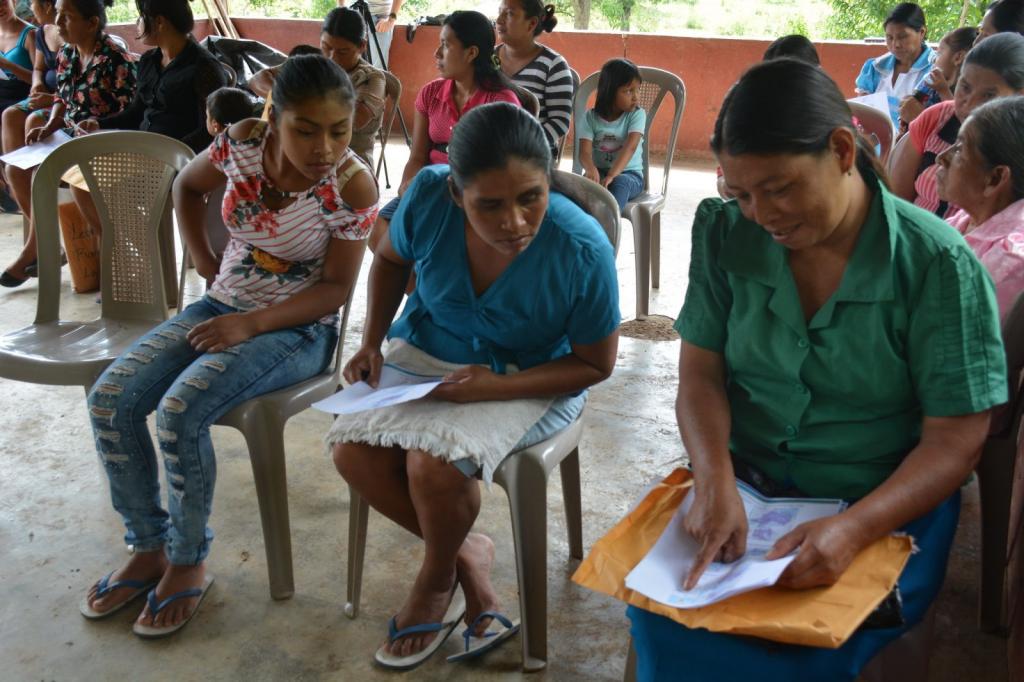Farmers in Olopa's CSV follow the path towards climate-smart agriculture

At the Climate-Smart Village in Olopa, Guatemala, we witnessed the different stages of implementing climate-smart agriculture practices.
The CGIAR Research Program on Climate Change, Agriculture and Food Security (CCAFS) developed the Climate-Smart Villages (CSV) approach, which aims to generate evidence on climate-smart agriculture (CSA). In the CSVs, different actors develop, adopt and evaluate CSA options in a participatory manner. This way, the CSVs contribute to increasing the resilience of rural communities to the effects of climate change.
In 2014, CCAFS Latin America established a CSV in Olopa, Chiquimula, Guatemala. Here, CCAFS, together with its local partner, the Asociación Regional Campesina Ch'orti' (ASORECH), coordinates the implementation of the CSV approach. Other local actors are also directly involved in the implementation. For example, during a recent visit, it became clear that a women’s group from the La Prensa community is leading the implementation of CSA options within the community. The motivation for their involvement is that the CSA options help local women to increase the productivity of their crops and improve their food security. This way, they can improve their livelihoods and simultaneously adapt to climate change.
Recently, we visited three communities that are part of the Olopa’s CSV: La Prensa, Nochán and Tuticopote. In each of them, the producers shared their experiences with the process of applying the CSV approach and the different stages of implementing CSA options. They also shared how the CSV approach has benefited their livelihoods.
On the way to climate-smart agriculture
Gathered in a communal hall, the women of La Prensa were able to comprehend how concepts like "probability", "temperature", “climate” and “weather" are connected to their crops. They enhanced their knowledge during the first workshop on the Participatory Integrated Climate Services for Agriculture (PICSA) methodology. PICSA is designed to increase farmers’ capacity to make informed decisions about their crops, using downscaled and site-specific climate and weather information. In La Prensa and the other communities of the CSV in Olopa, PICSA was implemented using the recommendations from the local agroclimatic bulletin, which is generated by the Local Technical Agroclimatic Committee (LTAC) of Chiquimula. This bulletin included recommendations for the village's main crops such as basic grains (beans and corn) and coffee.

Farmers from Olopa's CSV review the agroclimatic bulletin to make decisions about their crops. Photo: L. Sarruf (CCAFS)
During the visit, farmers from different farms in the community showed how they are implementing different CSA practices, and how these are helping to make their farms climate-smart. Some of the practices we saw include shaded-coffee, irrigation wells, reservoirs, water harvesting and vegetables home gardens.
Besides these CSA practices, the use of climate information has contributed a lot to increasing the farmers' harvests. As one of the farmers in La Prensa explains: “Before, we sowed every month. We had no guidance on when to sow, we did not know if we were going to harvest as expected or lose our crops. Now, we have learned with the training on PICSA and we are able to teach our neighbors. We shared information with them on when the rainy period will start or when the rain will stop, so that we all take measures to avoid losing our crops”.
Learning a new CSA practice
In Tuticopote community, we were able to see how farmers are implementing new CSA practices (sulfocalcic sprays and a foliar fertilizer known as “madrifol”), using agro-ecological inputs to fertilize coffee and bean crops. This enables farmers to avoid the use of chemicals. The agro-ecological inputs are produced with materials that are easy to use, which also reduce costs.
“With these climate-smart home gardens, families in our village are able to produce vegetables for their families; they won't have to buy them at the market. With these home gardens, they can also sell the surplus in the village or within the community. All the vegetables we grow are essential food for our families,” says Oscar, one of Tuticopote's farmers.
We ended the visit in Nochán. There, the farmers gathered to learn about how to implement the level curves practice, which is aimed at making better use of rainwater and protecting the soil from erosion. Claudia Lopez, an ASORECH’s local facilitator, explained to producers that this practice is the “basis to implement other practices. This practice enables the implementation of trenches contour, dead barriers, and hedgerows in their plots. Even if they want to plant another crop in their plot, they can do it using the curve tool they made”. By using this practice, crops retain more nutrients, soils are conserved, and plots retain more moisture, which results in better development of the crops.
As farmers increase their knowledge of the relationships between weather behavior and their crops, they also increase their understanding of the importance of each CSA practice implemented in the CSV. Each implemented CSA practice is then evaluated to understand how it contributes to each of the CSA pillars: productivity, adaptation, and mitigation. As a result, with the prioritization and implementation of the CSA practices mentioned above, the communities of Olopa’s CSV are progressing towards strengthening their capacities in understanding how climate change may affect their crops. At the same time, they are learning how to adapt and improve their food security and livelihoods.
Read more:
- News update: Playing to achieve sustainable agriculture
- News update: Gender, climate change and agriculture: Guatemala leads regional dialogue
Lauren Sarruf Romero is the Communications Officer for CCAFS Latin America.



